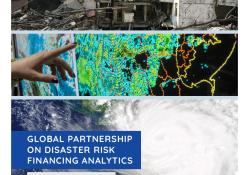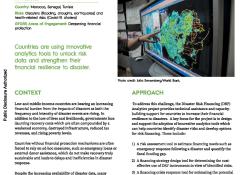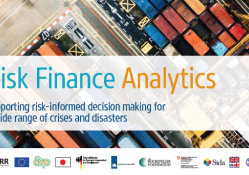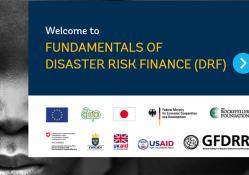Population growth, escalating concentration of assets, and climate change are increasing risk exposure and losses from natural hazards. Developing countries typically lack financial protection against the impacts of disasters and rely on retroactive budget reallocations, donor assistance, tax increases, or post-disaster loans to attempt to meet financing needs.
In December 2015, the European Union (EU) and World Bank/Global Facility for Disaster Reduction and Recovery (GFDRR) signed a partnership on disaster risk finance (DRF) analytics in order to help improve understanding and increase the capacity of governments to make informed decisions on DRF based on sound financial analysis. The project bridges the gap between catastrophe risk data, available commercial solutions, and informed sovereign DRF decision-making by developing and customizing DRF tools tailored to the capacity and data availability for each country. The overarching objective is to increase financial resilience of countries against natural disasters.
The Disaster Risk Financing Analytics Project is funded by the European Union, managed by the Global Facility for Disaster Reduction and Recovery, and implemented by the World Bank’s Disaster Risk Financing and Insurance Program.
Project implementation rests on four operational and interlinked pillars:
Pillar 1: Pilot-Country Implementation. The aim is to give governments in selected pilot countries access to improved tools and well-communicated technical information to support informed DRF decision-making. Financial disaster risk assessment are conducted to quantify the financial and fiscal impact of disasters, and to review the current financial protection strategies of these countries.
Pillar 2: Core Analytics Tools. Complementary to the implementation in pilot countries, a suite of generic tools is being developed, which can then be adapted and applied to support decision-making in additional countries. The design of the core tools considers findings on what has been viable and effective in the country implementation. View this presentation for more details.
Pillar 3: Knowledge Management. The third pillar includes specific, global knowledge-management activities, including an online training program, specific outreach materials, and regional workshops, for technical DRF practitioners, and for users of DRF analytics information, such as policymakers in governments and development agencies.
Pillar 4: Monitoring & Evaluation Framework for DRF Strategies. A monitoring and evaluation (M&E) framework to assess the impact of DRF programs links the work to be conducted under this project to M&E for sovereign risk-transfer solutions. It draws on lessons from ongoing initiatives and incorporates elementary risk analysis, to continue developing operationally feasible approaches to meaningfully evaluate the impact of DRF.
The Disaster Risk Financing Analytics Project is funded by the European Union, managed by the Global Facility for Disaster Reduction and Recovery, and implemented by the World Bank’s Disaster Risk Financing and Insurance Program.
In the Philippines, a financial disaster risk assessment was initially carried out which led to the formulation of policy options for DRF and to the preparation of customised country analytic tools. Following that, a customised analytics tool was developed and delivered to the Government of the Philippines, which included a training session and a customised user manual. This work directly supported the placement of a $206 million catastrophe risk insurance program in July 2017, as well as a renewal of the program for a $390 million coverage in December 2018. A second tool has been developed to address needs for broader and more comprehensive risk financing strategies at both state and provincial levels, as well as for most exposed cities.
Pakistan was included as a pilot country in late summer 2017. A preliminary financial disaster risk assessment was completed, and preliminary DRF policy options were identified. Following a specific request, a customised analytics tool was developed for the Government of Punjab to support decision making for a crop insurance program. For Sindh, advanced discussions with the Department of Finance helped finalise the fiscal disaster risk assessment and ascertain priorities for the province’s disaster risk financing strategy. At national level, further consultations with the Government of Pakistan in 2018 led to the development of DRF analytics tools to support a national DRF strategy and secure a line of credit.
In coordination with EU development officials, engagements with pilot countries followed a pre-defined set of activities. The pace of implementation is aligned to national demand and capabilities.
Over the course of the program, this pillar evolved to include two different sets of tools in contrast to just one set of tools as initially foreseen. The analytics tools are grouped in so-called ‘phase 1’ and ‘phase 2’ tools. Phase 1 tools describes the development of the original core analytics tools which build on pilot country as well as non-pilot country engagements. Phase 2 tools are exploratory in nature and aim to integrate the latest innovation and disruptive technologies.
The general aim of Phase 1 tools is to support stakeholders on DRF decision making. More specifically, the objective is to help developing country governments to understand their financial exposure to natural disasters, employ efficient financial/actuarial analysis in the development of disaster risk financing strategies, benchmark various risk financing instruments, improve capacity to meet financial needs immediately following natural disasters, and develop the ability to monitor and evaluate DRF strategies. Phase 1 tools are generic in nature, facilitating the dissemination to and application in any given country.
Emergency Funding Assessment Tool
By the end of 2019, three analytics tools have been created and these include:
- An Emergency Funding Assessment Tool to estimate the emergency response needed following a natural disaster and quantify the fiscal funding gap.
- A Risk Financing Evaluation and Risk Transfer Optimisation Tool to evaluate the cost-effectiveness of DRF instruments and strategies.
- A Financing Crisis Response Tool to estimate the potential coverage and cost of a social safety net program.
Subsequently, experience from the tool development has been used in other countries and lessons learned have in turn fed back into the refinement of core analytics tools. For example:
- In Kenya, the Risk Financing Evaluation and Risk Transfer Optimisation Tool simulated and derived the most cost-efficient way to finance drought and flood-related response costs. A layered-up financial strategy was then produced, combining line of credit and insurance whilst minimizing overall annual cost.
- In Senegal, a virtual historical loss data estimation tool was built to help the Government dimension a scalable safety net against drought risk and complement scarce historical data on crop yields and population affected.
- In Morocco, a comprehensive national disaster risk financing strategy was set up based on sensitivity analyses from the Risk Financing Evaluation and Risk Transfer Optimisation Tool.
- In Vietnam, the Risk Financing Evaluation and Risk Transfer Optimisation Tool specifically informed national and sub-national DRF engagements, on the critical issue of evaluating most relevant combination of ex-ante instruments, for a wide range of scenarios, and to benefit a large spectrum of beneficiaries and over various geographic scales.
- In Serbia, Tunisia and Albania, the tools supported awareness raising on the benefits of DRF policy, as well as directly supported the evaluation of various risk financing instruments from a quantitative perspective.
Next-generation Drought Indices and Indicators
In 2018, the DRF Analytics team had explored the potential development of additional analytics tools for the remaining project period. At the end of 2018, through consultations with the European Commission, it was jointly agreed to focus implementation on the development of additional DRF tools under a second phase within this pillar of activity. The development of these Phase 2 tools is ongoing momentarily and proceeding as anticipated and in line with the work plan. It is expected that the following additional DRF tools will be developed by 2021:
- A Global Flood Monitoring Platform, developed in close consultation with the European Commission’s Joint Research Centre and now being deployed in Southeast Asia;
- Satellite-based Financial Exposure Mapping, delivered for Morocco and currently being piloted in Tunisia;
- Next-generation Drought Indices and Indicators, with first results delivered in 2019/2020 for Senegal, Mozambique, Malawi and India;
- Artificial intelligence, big data and machine learning for Rainfall and Impact-level Loss Estimation (e.g. based on satellite data, and online/social media mining), with significant developments in 2019 with targeted applications in 2020 tentatively in Bangladesh, Sierra Leone, Morocco, Benin, Niger and possibly Albania.
- An exploratory tool addressing broader range of risks and peril types, starting from landslides, locust swarms and recently compound risk from Covid-19 and health emergencies.
For more details about both set of tools and a visual presentation of their capabilities, please consult this presentation.
Work under this pillar focused on the development of face-to-face training programs and delivery of these programs, development of e-learning modules, and knowledge materials such as flyers and brochures.
In partnership with Cambridge University, a five-day Executive Education Training Program on DRF was developed. The DRF Analytics program financed the development of the analytics training modules. The first running of the Executive Education course took place in July 2018 in Cambridge, UK, and was since then replicated in Cape Town, South Africa, in partnership with the Stellenbosch University in September 2019.
A dedicated training program is currently being developed for the core analytics tools of pillar 2 and expected to be finalized by 2021.
In June/July 2019, two regional DRF trainings have been delivered in Dakar, Senegal, in coordination with Africa Risk Capacity (ARC) and the United Nations, and with co-funding from the DRF Analytics program. It was held in two sessions over two weeks: the first was attended by 28 English-speaking practitioners from four anglophone countries; and the second by 27 French-speaking practitioners from nine francophone countries.
The team has also developed and finalized a couple of e-learning modules focusing on DRF Analytics. The centerpiece is the Introduction to Disaster Risk Financing Analytics module. Disaster risk financing analytics training exercises have also been developed (password available upon request). Both modules complement the Fundamentals of DRF module.
In 2017, World Bank developed and published a theoretical framework to evaluate sovereign DRF strategies. Under this program the framework has been tested and used to support DRF analyses in client countries, for instance in the Philippines, Morocco, Fiji, and Kenya. The framework also formed the basis of the ‘Risk Financing Evaluation and Risk Transfer Optimisation Tool’ – one of the three Phase 1 tools developed under pillar 2.
The main objective of this component is to design a Monitoring and Evaluation (M&E) Guide that builds on the initial framework and helps sovereigns and all other stakeholders interested in DRF strategies to understand the specifics of M&E and to design and implement an adequate M&E system for each DRF strategy. The Guide outlines the specifics of the M&E system with the purpose to facilitate accountability and critical learning, create evidence, adjust and correct the course of actions to improve performance.
As part of the development of the operational guide, the team first produced an explanatory note about sovereign DRF strategies. This explanatory note sets the scene for all interested stakeholders to understand the concept and the elements of a comprehensive DRF strategy. It is designed as a high-level document to create a common understanding for the WB and its partners to align efforts in designing, implementing, learning from, and improving DRF strategies. It is also designed to facilitate policy dialogue between financial and non-financial experts towards realizing a DRF strategy through the prism of disaster management priorities of each country. The explanatory note furthermore provides a universal definition of DRF strategies.
The actual M&E Guide explains the specifics of three different types of evaluations, namely process, performance and impact evaluations, and provides an overview about when and how each evaluation can serve its purpose. The Guide details further the methodologies and tools that can be explored for each evaluation. It also provides a universal framework of performance measurement areas (PMAs) for monitoring DRFI Strategies, which can be further tailored to the specifics and needs of each DRF strategy individually. The Guide reflects also on the governance mechanism as well as the resources necessary for the M&E. The approach towards the M&E Guide is such that it allows for (a) universality in the design, creating foundations for M&E system for any DRF strategy, and (b) comprehensiveness, whereby the proposed PMAs serve as a menu-list to choose from for careful calibration of each M&E system towards a unique combination of the context-specific factors for each individual DRF strategy.





